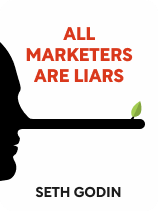

This article is an excerpt from the Shortform book guide to "All Marketers are Liars" by Seth Godin. Shortform has the world's best summaries and analyses of books you should be reading.
Like this article? Sign up for a free trial here .
Do you use storytelling in advertising? Why is this technique so effective?
Good storytelling is the key to good marketing, according to author Seth Godin. In All Marketers Are Liars, he discusses the power of storytelling and discusses six elements that make a story good.
Keep reading to learn how to use storytelling in advertising.
Using Storytelling in Advertising
In All Marketers Are Liars, Seth Godin contends that good marketing is good storytelling. Often, the story you tell about a product is more important than the product itself. If you can tell an effective story that resonates with a customer’s worldview, your message will be more likely to stand out in our increasingly crowded marketplace. Godin defines marketing broadly as spreading ideas, so if you have an idea to spread, you’re a marketer. Therefore, his principles can be applied to many areas of life: selling products, applying for jobs, running for political office, and more. His ideas will help you tell a compelling story.
Seth Godin is a writer, entrepreneur, public speaker, marketer, and blogger who has written 19 books, mainly focusing on 21st-century marketing. In his previous book Purple Cow, he discusses the importance of finding and marketing a remarkable product (which he calls a purple cow). In All Marketers Are Liars, he changes direction, focusing on how a remarkable story can elevate a good product.
Godin breaks down his ideas into five principles. To effectively use storytelling in advertising, Godin says you need to understand worldviews and how customers process information. Once you start thinking like a consumer, you can tailor your product story to make a good first impression. He then explains how to avoid the fine line between telling a story with a “fib” that appeals to emotions and committing fraud. In the final principle, he talks about common obstacles you may encounter, as well as how to overcome them.
The Power of Storytelling in Advertising (Lying)
Because people often buy based on emotion rather than need, it’s important for marketers to appeal to beliefs and feelings. This can involve lying by a certain definition. Godin defines lies as stories people tell themselves, which marketers build on. He uses the terms lying and storytelling interchangeably.
He claims the consumer’s belief in a marketer’s lie makes it true. The product usually doesn’t fix a real problem or need (at least, not any better than a competitor’s cheaper option). Therefore, our belief in how the product will make us feel is what we’re really buying.
For example, compare a pair of $20 Lenovo wireless earbuds with $159 AirPods. They both let you listen to music without the hassle of getting tangled in cords. So why spend the extra $139? You probably like the AirPods better for some reason, right? Godin would attribute this to your belief that using the AirPods makes you cool, despite the fact they’re just a pair of wireless earbuds.
| Let’s Address the Elephant in the Room When All Marketers Are Liars was initially released, many readers were confused by the book’s title. They wondered how marketing constituted lying and whether Godin was advocating lying. There are two ways to understand the title—we’ll discuss one way now, and the second way in Principle 4. Throughout the book, Godin advocates honesty and authenticity in marketing. This seems to contradict his statement that marketers are liars. However, the distinction is in Godin’s definition of lying as simply telling a story your customers want to believe, that therefore resonates with them—for instance that your product will make them feel better or be more attractive. This differs from the usual definition of lying as misstating objective facts. |
The Elements of a Good Story
Telling a good story is key to ensuring that you successfully spread your idea or sell your product. But what makes a good story? To Godin, effective stories are trusted, authentic, subtle, fast, targeted, and make a promise.
Make It Trusted
To effectively use storytelling in advertising, your story must be based in reality. Even if your story is not objectively factual, the belief in your story must be mutually beneficial for both you and the customer. If your story isn’t true and your customers find out you deceived them, you’ll lose their trust, and it’ll be difficult to earn it back.
| Trust-Based Marketing Godin believes customer trust is a key element of a good story. One method of building trust is to use trust-based marketing, where you form a meaningful relationship with your customer based on honesty and unbiased information. There are many ways to build trust with your customer, but we’ll group them into three general themes, based on Aristotle’s Modes of Persuasion: Ethos, or credibility: This often comes in the form of endorsements from people of prestige or authority (like doctors or lawyers), from an influencer or celebrity (depending on the product), or a friend. A demonstration of your product could also increase credibility. Pathos, or emotion: This tactic revolves around appealing to emotions. Having a shared worldview or philosophy with a consumer would fit in this category. Familiarity can also be a form of pathos. Logos, or logic: This might look like citing evidence or studies for why your product works. Technology companies use this when they list all of their improved product specs. Ideally, you’d use some form of all three of these modes to build trust with your customer. |
Make It Authentic
Your story must align with your company, product, and overall image. Godin notes that because of the ease of access to information granted by the internet, it’s easier for consumers to fact-check and hold companies accountable. This makes it even more important to be honest and authentic with your messaging.
For example, BP has faced criticism for touting its sustainability and low-emission energy, because this eco-friendly story doesn’t authentically align with BP’s public history as a leader in the gas and oil industry.
| Define Your Mission to Ensure Authenticity How do you align your story with your company? Try defining your mission as a company. In Start With Why, Simon Sinek discusses the importance of defining your mission and why you’re doing what you’re doing. That way, you have a clear set of values that will guide your stories authentically. To define your mission, start by asking yourself these questions: Why are you doing what you’re doing? Does it bring you or the consumer joy? Or is it just a way to make money? How are you providing value? What makes your idea or product special? You should be offering your customer some kind of value—whether in the form of a service, product, or idea—and it should make your consumer’s life better in some way. Who benefits from what you’re providing? If you’re the only one benefiting from it, you may want to spend some time reflecting on your product. Then work on turning those answers into a concise mission statement as a reminder to stay authentic to these values in your marketing. |
Make It Subtle
Your customer will make a judgment about your product and fill the gaps in the narrative. Godin believes you should focus on incorporating your marketing story into your product and brand, rather than on overexplaining it to your customer. To effectively use storytelling in advertising, you must make it subtle.
For example, in 1999, Nike ran a one-minute advertisement honoring the career of athlete Michael Jordan. It wasn’t until the last few seconds of the commercial that Nike included its signature swoosh logo and “Just Do It” slogan at the bottom of the screen. Nike was subtle about its message, while still creating a compelling ad that aligned with its value of excellence in sports.
| Subliminal Messaging Godin’s idea of subtlety in marketing is not a new one. Have you ever noticed the arrow hidden in FedEx’s logo? Or how in Baskin Robbins’s sign, the number “31” (for their flavors) is in pink? These are two examples of subliminal messaging in advertising. This is the idea of using subtle cues to encourage your consumer to make certain subconscious associations—without being aware of it—about a brand and their story. It’s a tactic more commonly associated with old advertising. One of the most famous instances involving a Coca-Cola advertisement occurred in the 1950s (although science later debunked the tactic as ineffective). |
Make It Fast
Think of the last time someone told you a joke. Did you get the joke? Or did they have to explain the punchline to you? If yes, did you find it that funny? Marketing works in the same way. Godin says your story has to engage potential customers quickly while you have their attention. If your story takes lots of explaining, they probably won’t listen. Nobody likes to wait for the punchline.
| Thinking Fast Other experts echo Godin’s claim that messaging should be fast. In Thinking, Fast and Slow, Daniel Kahneman discusses our two thinking systems: System 1: our automatic and quick way of thinking. System 1 wants to make sense of the world and works in terms of what is and isn’t normal. System 2: our capacity to dedicate meaningful, deliberate attention to complex problems. System 2 requires our conscious attention. It’s important to make your story fast because people are generally working in the quick System 1. They may not switch to System 2 to dissect complexities or meaning from your message. |
Make It Targeted
As Godin explains in the introduction, the age of mass marketing is over—if you try to appeal to everyone, you’ll appeal to no one. As a marketer, there’s more power in targeting a niche and building a strong sense of community around your product within that niche. These niche customers will be more likely to recommend your product to friends of similar interests.
| Create a Persona to Find Your Niche While Godin doesn’t explain how to target a niche, other authors offer insight on how to choose an audience. One way to do this is by creating an ideal customer profile or ideal persona. This involves building a fictional person who would use your product. It combines metrics (like age) with psychology (like what kinds of products they need). Here are a few questions to come up with an ideal consumer: What’s their name? How old are they? What do they do for a living? Where do they live? What do they do for fun? What kind of media do they use? What upsets them about the world? What would they like about your product? Where might they hear about your product? In Crossing the Chasm, Geoffrey Moore outlines steps to identifying your niche. After generating customer profiles based on the questions above, build purchasing scenarios. Think about how your customers in your profiles might come across your product and how they would use it. Once you’ve developed these scenarios, select the best one. Then ask yourself if any of your competitors are already in this niche. Once you have a solid idea of your niche, all of your marketing decisions will be tailored to a specific kind of person, instead of the masses. Some companies even find stock photos for their persona and keep them in their offices as a constant reminder to put their target customer first. |
Make a Promise
Your marketing story should make a promise to your customer, and most importantly, it should deliver on that promise. Tell the customer what value they’ll gain from your product, then provide that value.
For example, Old Spice ran a campaign called “The Man Your Man Could Smell Like.” The ads targeted women and their perception of their ideal man, promising that if her partner wore Old Spice, he would smell like her ideal man. This was a promise Old Spice could make and realistically keep.
| How to Tell a Story Godin emphasizes the importance of telling a good story. He offers a few characteristics of a good story, but he doesn’t give much actionable advice on crafting a story. So where should you start? In Building a StoryBrand, Donald Miller discusses a common seven-part story arc. It’s effective because it captures the human condition well by addressing our common needs and wants. It looks like this: A hero (your customer) wants something, and the challenge of getting it is inherently interesting. Your product can fix the hero’s problem. A guide (your brand) will help them reach the thing they want. Having a guide is important to the story because if the hero could fix her own problem, she would. The guide gives the hero a solid plan of action. This could look like an explanation of how to use your product. A call to action forces the hero to act or shows her what she has to lose if she doesn’t act. These are prompts that help you guide the customer to buy or sign up for your product. Introduce negative stakes that force your customer to ask why she should care. What will she gain by acting? Show the customer her vulnerabilities, and tell her how your product can reduce them. Incorporate this narrative arc into your message, and you’ll craft more compelling stories in your marketing. |

———End of Preview———
Like what you just read? Read the rest of the world's best book summary and analysis of Seth Godin's "All Marketers are Liars" at Shortform .
Here's what you'll find in our full All Marketers are Liars summary :
- The difference between lying and telling a great story
- How to better understand your customer
- How to overcome common obstacles you’ll encounter in marketing






